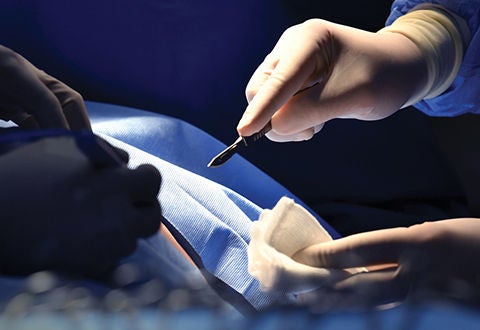
Minimally invasive cardiac surgery is a surgery where the surgeon performs the heart operation through a small incision on the side of the chest in between the ribs, as opposed to conventional open-heart surgery.
By Asst Prof Chua Kim Chai, Consultant, Department of Cardiothoracic Surgery
Traditionally, cardiac surgery is carried out through median sternotomy, which unavoidably subjects a patient to a lengthy two to three months full recovery post-cardiac surgery. For minimally invasive cardiac surgery (MICS), the exposure of cardiac surgical field is gained through a small 3-5cm thoracotomy instead. Just like cholecystectomy, in the current era, it is by default performed through minimally invasive technique rather than open surgery, MICS has also become the default approach for certain cardiac conditions in some high-volume overseas centres.
What are the types of MICS?
Nowadays, it is possible to perform selected coronary artery bypass graft and valvular surgeries using minimally invasive techniques.
The most common coronary artery bypass grafting procedure is the single graft bypass performed on left anterior descending (LAD) artery stenosis – minimally invasive direct coronary artery bypass (MIDCAB), usually on a beating heart. This can be part of a hybrid revascularisation strategy for multi-vessel disease as well.
In aortic valve replacement, the minimally invasive approach is done either through the partial upper sternotomy or right mini thoracotomy to access the diseased valve. In mitral valve repair/replacement, the surgery is performed through right mini thoracotomy, sometimes done with concomitant maze and/or tricuspid valve repair procedure. Not forgetting catheter-based procedures such as transcatheter aortic valve implant and mitral clip which are also part of MICS.
In a MIDCAB procedure, the patient is positioned in a slight right decubitus position and put on single right lung ventilation to allow better visualisation in the left chest. A small 4-5cm incision is made on selected intercostal space to gain exposure to target vessels. A specialised retractor is then applied through the incision to elevate the left side of the chest to allow harvesting of the left internal mammary artery (LIMA). Then a suction device is used to stabilise the LAD artery on a beating heart, and anastomosis is performed thereafter. |
|---|
MICS vs open-heart surgery
Many studies1-4 have shown that minimally invasive valve surgery has multiple established benefits compared to the conventional sternotomy approach. MICS reduces the need for blood transfusion and length of hospitalisation stay. It has faster recovery which could reduce medical costs and allows patients to have a better quality of life as well as a better experience from the cosmetic result.
For coronary surgery, LIMA-LAD has established superior long-term outcome that is unrivalled by percutaneous coronary intervention (PCI). However, with the current advancement of newer generations of coronary stents and their improved durability, the long-term benefits of vein or radial grafts are being challenged. Thus, the concept of hybrid revascularisation arises where the surgeon does LIMA-LAD, and the cardiologist does stenting of non-LAD lesions. This allows a patient to enjoy the advantages of both MIDCAB + PCI, and at the same time eliminates the disadvantages of both procedures5-6.
While there is no true disadvantage of MICS, additional pre-operation investigations [computed tomography (CT) of the chest, lung function test, vascular scan, etc] may be required. As the surgeon has to operate through a small incision, it is important to ensure that there are adequate information and careful planning prior so as achieve a higher success rate of MICS.
A comparison of visible scars done through open-heart surgery (left) and minimally invasive cardiac surgery (right).
Patient selection for MICS
Few conditions may preclude a patient from having MICS. These include extreme chest wall deformity (severe pectus excavatum), advanced pulmonary disease, poor right heart function or peripheral vascular disease. If a patient needs a complex surgery such as coronary work plus valve surgery, the MICS approach is not suitable. Thus, for isolated coronary or valve condition, any patient without the above contraindications who wish to avoid sternotomy may be offered the MICS approach after further evaluation by a specialist surgeon.
The benefits are usually more prominent in young adults who wish to return to their active daily life, and also in the very old group of patients whom sternotomy healing may expect to be prolonged or the cardiopulmonary function be affected post-sternotomy.
MICS offered in NHCS
- Bioprosthetic or mechanical aortic valve replacement
- Mitral valve repair or replacement, with or without concurrent tricuspid valve repair
- MIDCAB, either stand-alone or as a hybrid procedure
- Atrial myxoma removal
- Atrial septal defect closure
- Catheter-based procedure – transcatheter aortic valve implantation (TAVI) and Mitraclip
1. Cheng DC, Martin J, Lal A, et al. Minimally invasive versus conventional open mitral valve surgery: a meta-analysis and systematic review. Innovations (Phila). 2011;6(2):84–103.
2. Glower DD, Landolfo KP, Clements F, et al. Mitral valve operation via port access versus median sternotomy. Eur J Cardiothorac Surg. 1998;14(Suppl 1):S143–7.
3. Casselman FP, Van Slycke S, Wellens F, et al. Mitral valve surgery can now routinely be performed endoscopically. Circulation. 2003;108(Suppl 1):II48–54.
4. Modi P, Rodriguez E, Hargrove WC 3rd, et al. Minimally invasive video-assisted mitral valve surgery: a 12-year, 2-center experience in 1178 patients. J Thorac Cardiovasc Surg. 2009;137(6):1481–1487
5. Ali Hage, Vincenzo G, Bob Kiaii, et al. Hybrid Coronary Revascularization Versus Off-Pump Coronary Artery Bypass Grafting: Comparative Effectiveness Analysis With Long-Term Follow-up. JAHA. 2019 Dec 17;8(24):e014204
6. Vincenzo G, Ahmad Hafiz, Bob Kiaii, et al. Is the Future of Coronary Arterial Revascularization a Hybrid Approach? The Canadian Experience Across Three Centers. Innovations 2017;12:82–86













 Get it on Google Play
Get it on Google Play